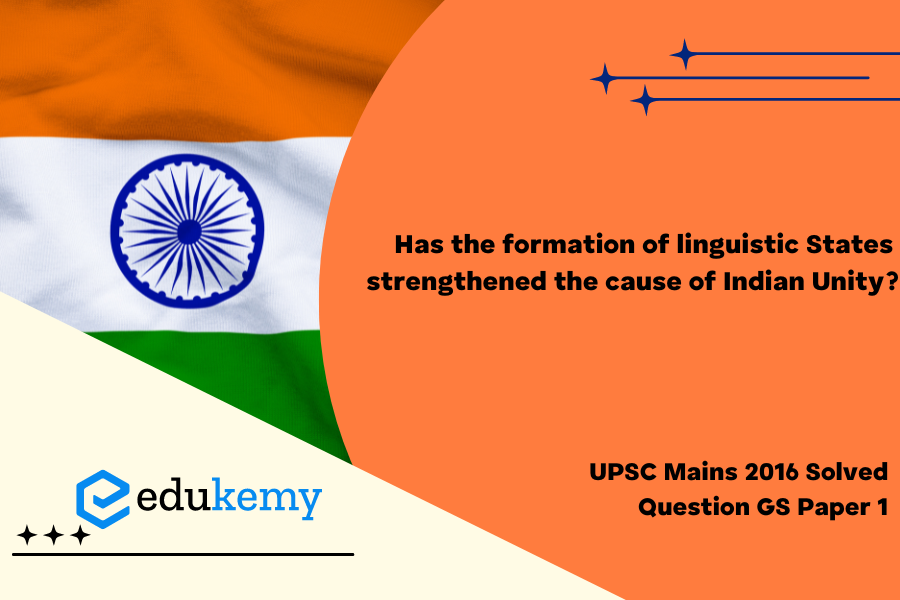The formation of linguistic states in India has been a crucial aspect of the nation’s sociopolitical landscape, shaping its unity and diversity. The linguistic reorganization of states, primarily initiated with the creation of Andhra Pradesh in 1953, aimed to address regional linguistic disparities and foster a sense of cultural affinity among the diverse populace. The proponents of linguistic states argued that such divisions would empower communities to govern themselves based on a shared language, leading to better governance and social cohesion. However, the question of whether this restructuring has genuinely strengthened the cause of Indian unity remains complex and multifaceted. On one hand, linguistic states have provided a platform for the preservation and promotion of distinct cultural identities, contributing to the rich tapestry of India’s diversity. On the other hand, challenges such as linguistic chauvinism, inter-state disputes, and occasional tensions between linguistic groups have raised questions about the actual impact of linguistic states on national unity. This essay will explore the various dimensions of this issue, examining both the positive and negative repercussions of the formation of linguistic states on the overarching goal of fostering a united and harmonious India.
Tag: Post-independence consolidation and reorganization within the country.
Contents
Decoding the Question:
- In the Introduction, try to mention how the formation of linguistic States in India has taken place.
- In Body, elaborate on how the formation of linguistic States strengthened the cause of Indian Unity.
- Conclude with mentioning the apprehensions of various leaders and the reality concerning the role of the languages in uniting India.
Answer:
At the time of Independence, India was fragmented into 543 princely states and provinces of British Indian states and right after the succession of principalities into the Indian Union, the question of the criteria of integrating these kingdoms and provinces into feasible administrative units came up. The freedom struggle and national movement not only created a pan-Indian national unity but also generated distinct unity around a common language, region, and culture.
Formation of Linguistic States Strengthened the Cause of Indian Unity:
- Constitutionally recognized: In December 1953, the States Reorganization Commission was set up and it recommended the creation of linguistic States. Article 3 of the Constitution of India recognizes the separate identity of the regions and does not believe that the states, districts and mandals within India are static, unchanging, and permanent. They had the maturity to accept that states would evolve and change, and hence made provisions for the creation of new states in the Indian Union.
- Recognition of regional aspirations: Democratic politics allows parties and groups to address the people based on their regional identity, aspirations, and specific regional problems. During democratic politics, regional aspirations get strengthened. Democratic politics also means that regional issues and problems will receive adequate attention and accommodation in the policy-making process. Governance would be made easier in areas, which shared linguistic and geographical features.
- Formation of linguistic States: Linguistic States also grant autonomy to cultural and linguistic issues and minimize protests and resentment. For instance, the opposition to the domination of Hindi (in Tamil Nadu) or imposing Bengali caused huge protests from the Gurkhas community, are instances of this. In erstwhile Pakistan and Sri Lanka, imposing one language has led to separation and insurgency, respectively.

- Ethno-national identity: In India. Language coupled with regional and tribal identity and not religion has provided the most powerful instrument for the formation of ethno-national identity in India. Rather, a combination of ethnicity based on tribal identity, language, regional deprivation, and ecology provided the basis for intense regionalism resulting in statehood.
- Unity in diversity: India is united by its linguistic diversity and sufficient devolution of power to states built on the lines of language. What will divide India is pushing any one language as superior to other Indian languages, as was done for Urdu in Pakistan.
Challenges Posed to Indian Unity:
- Language-Based Divisions: The creation of linguistic states can inadvertently lead to linguistic divisions, sometimes pitting one linguistic group against another. This can strain inter-community relations and weaken the sense of national unity.
- Ethnic Tensions: In some cases, linguistic reorganization has exacerbated existing ethnic tensions or conflicts, which can hinder national unity. The demand for separate states based on linguistic identity can sometimes overlook other factors that contribute to a region’s identity.
- Economic Disparities: The creation of smaller linguistic states might lead to resource disparities, as some states may have more developed economies than others. This could impact the overall economic unity of the country.
- Regionalism: Linguistic states could inadvertently promote regionalism, where people identify more with their linguistic and regional identities than with their national identity. This can weaken the sense of Indian unity.
The Report of the States Reorganization Commission (SRC), which was implemented on November 1, 1956, has helped transform the political and institutional life of the nation. In the early 1950s, many including Prime Minister Jawaharlal Nehru feared that states based on language might hasten a further subdivision of India. In fact, something like the reverse has happened. Far from undermining Indian unity, linguistic States have helped strengthen it. It has proved to be perfectly consistent to be a Kannadiga and an Indian, a Bengali and an Indian, a Tamil and an Indian, or a Gujarati and an Indian together.
In case you still have your doubts, contact us on 9811333901.
For UPSC Prelims Resources, Click here
For Daily Updates and Study Material:
Join our Telegram Channel – Edukemy for IAS
- 1. Learn through Videos – here
- 2. Be Exam Ready by Practicing Daily MCQs – here
- 3. Daily Newsletter – Get all your Current Affairs Covered – here
- 4. Mains Answer Writing Practice – here


